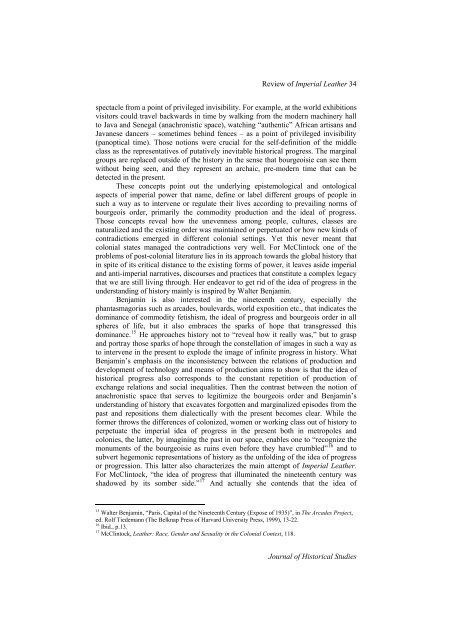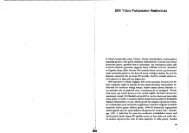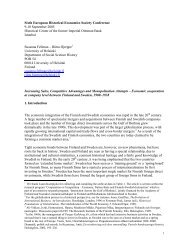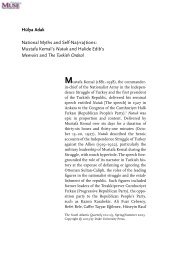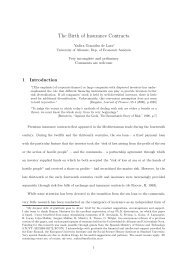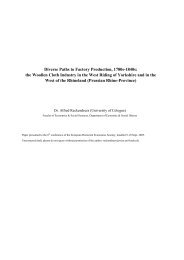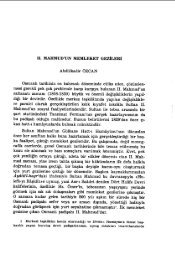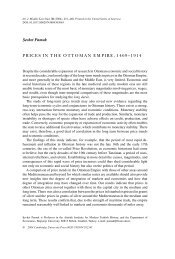Anne McClintock, Imperial Leather - The Ataturk Institute for Modern ...
Anne McClintock, Imperial Leather - The Ataturk Institute for Modern ...
Anne McClintock, Imperial Leather - The Ataturk Institute for Modern ...
You also want an ePaper? Increase the reach of your titles
YUMPU automatically turns print PDFs into web optimized ePapers that Google loves.
Review of <strong>Imperial</strong> <strong>Leather</strong> 34<br />
spectacle from a point of privileged invisibility. For example, at the world exhibitions<br />
visitors could travel backwards in time by walking from the modern machinery hall<br />
to Java and Senegal (anachronistic space), watching “authentic” African artisans and<br />
Javanese dancers – sometimes behind fences – as a point of privileged invisibility<br />
(panoptical time). Those notions were crucial <strong>for</strong> the self-definition of the middle<br />
class as the representatives of putatively inevitable historical progress. <strong>The</strong> marginal<br />
groups are replaced outside of the history in the sense that bourgeoisie can see them<br />
without being seen, and they represent an archaic, pre-modern time that can be<br />
detected in the present.<br />
<strong>The</strong>se concepts point out the underlying epistemological and ontological<br />
aspects of imperial power that name, define or label different groups of people in<br />
such a way as to intervene or regulate their lives according to prevailing norms of<br />
bourgeois order, primarily the commodity production and the ideal of progress.<br />
Those concepts reveal how the unevenness among people, cultures, classes are<br />
naturalized and the existing order was maintained or perpetuated or how new kinds of<br />
contradictions emerged in different colonial settings. Yet this never meant that<br />
colonial states managed the contradictions very well. For <strong>McClintock</strong> one of the<br />
problems of post-colonial literature lies in its approach towards the global history that<br />
in spite of its critical distance to the existing <strong>for</strong>ms of power, it leaves aside imperial<br />
and anti-imperial narratives, discourses and practices that constitute a complex legacy<br />
that we are still living through. Her endeavor to get rid of the idea of progress in the<br />
understanding of history mainly is inspired by Walter Benjamin.<br />
Benjamin is also interested in the nineteenth century, especially the<br />
phantasmagorias such as arcades, boulevards, world exposition etc., that indicates the<br />
dominance of commodity fetishism, the ideal of progress and bourgeois order in all<br />
spheres of life, but it also embraces the sparks of hope that transgressed this<br />
dominance. 15 He approaches history not to “reveal how it really was,” but to grasp<br />
and portray those sparks of hope through the constellation of images in such a way as<br />
to intervene in the present to explode the image of infinite progress in history. What<br />
Benjamin’s emphasis on the inconsistency between the relations of production and<br />
development of technology and means of production aims to show is that the idea of<br />
historical progress also corresponds to the constant repetition of production of<br />
exchange relations and social inequalities. <strong>The</strong>n the contrast between the notion of<br />
anachronistic space that serves to legitimize the bourgeois order and Benjamin’s<br />
understanding of history that excavates <strong>for</strong>gotten and marginalized episodes from the<br />
past and repositions them dialectically with the present becomes clear. While the<br />
<strong>for</strong>mer throws the differences of colonized, women or working class out of history to<br />
perpetuate the imperial idea of progress in the present both in metropoles and<br />
colonies, the latter, by imagining the past in our space, enables one to “recognize the<br />
monuments of the bourgeoisie as ruins even be<strong>for</strong>e they have crumbled” 16 and to<br />
subvert hegemonic representations of history as the unfolding of the idea of progress<br />
or progression. This latter also characterizes the main attempt of <strong>Imperial</strong> <strong>Leather</strong>.<br />
For <strong>McClintock</strong>, “the idea of progress that illuminated the nineteenth century was<br />
shadowed by its somber side.” 17 And actually she contends that the idea of<br />
15 Walter Benjamin, “Paris, Capital of the Nineteenth Century (Expose of 1935)”, in <strong>The</strong> Arcades Project,<br />
ed. Rolf Tiedemann (<strong>The</strong> Belknap Press of Harvard University Press, 1999), 13-22.<br />
16 Ibid., p.13.<br />
17 <strong>McClintock</strong>, <strong>Leather</strong>: Race, Gender and Sexuality in the Colonial Contest, 118.<br />
Journal of Historical Studies


